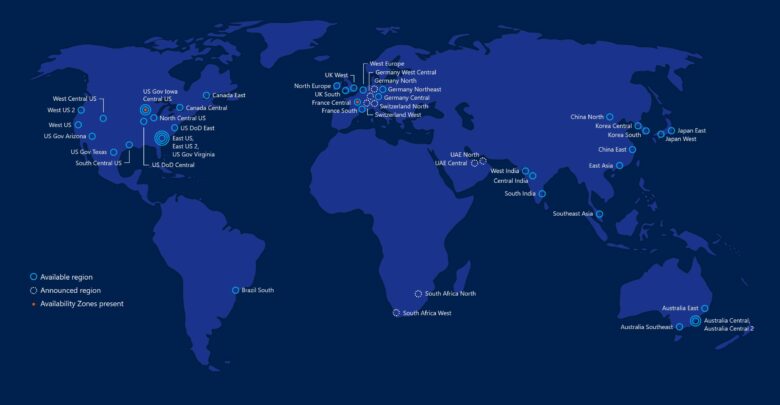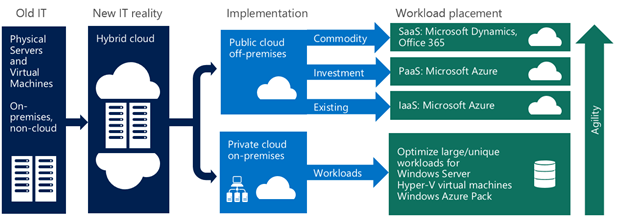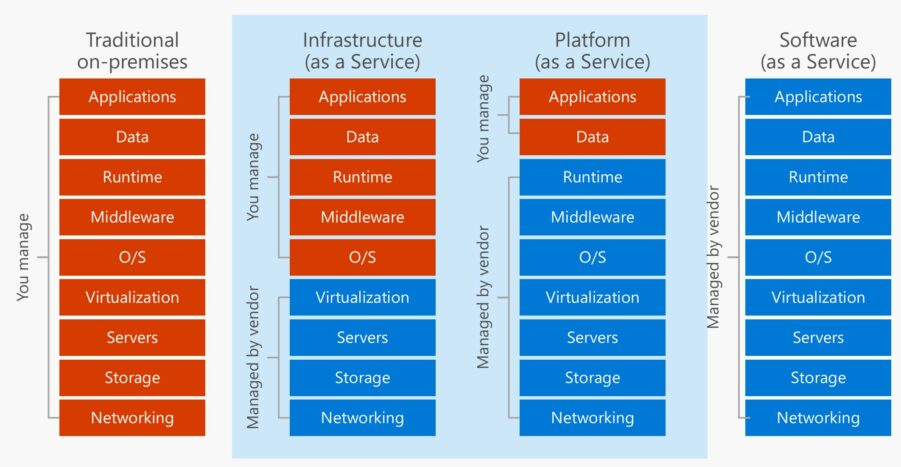
The Cloud journey
Cloud computing is now mainstream, with 90% of enterprises planning to maintain or boost spending on it this year, nearly six times the growth rate of enterprise IT spending as a whole.
The “Big Four”: AWS, Microsoft, IBM, and Google, now generate collective revenues of over half of the cloud computing market and had a combined market share of 53%.
The emergence of cloud computing represents a significant shift in the way enterprise IT develops, operates, and supports applications, because it is essentially an application-centric operations model. While developing cloud applications is still a relatively new IT priority, enterprises are already reaping the benefits, such as cost savings and increased agility. In addition to requiring developers to rethink how they program, test, and deploy applications, cloud application development is spurring new processes like DevOps and continuous development, which break down IT silos and accelerate the delivery of new applications. Hybrid architectures are expected to continue to dominate enterprise strategies, creating both opportunities as well as challenges.
Although cloud services have been a major battleground for years, the advent of microservices and container platforms has emerged as a competitive differentiator. Containerization of workloads is gaining wide acceptance, helping developer efficiency by reducing overhead associated with virtual machines, It seems that microservices crept out of nowhere and were suddenly everywhere. Opensource and mobile are also increasingly growing in importance in cloud computing environments.
The people outside the world of IT may not know that there are multiple types of cloud, while there isn’t a specific industry or workload that universally makes sense for each type of cloud, there are certain considerations enterprises should take into account when deciding upon the right fit: for example, does the company frequently handle sensitive customer information online? do they have a highly secretive recipe or patented design that needs to be protected? In these cases, public solutions may be a riskier choice.
The public cloud
In a nutshell, it is generally the most well-known and straightforward type of cloud computing. Public providers typically offer convenience — it’s easy for enterprises and developers to set up, use and access the public cloud. Additionally, scalability is often a driving factor for businesses utilizing the public cloud. However, this type of cloud is not without risks.
Here’s a brief breakdown of some of the main characteristics of the public cloud:
- Easy to use: Some developers may favor the public cloud (at least in the U.S.) due to its ease of access. Generally, the public cloud operates at a pretty fast speed, which is also alluring to some enterprises.
- Typically a pay-per-use model (cost-effective): Often, public clouds operate on an elastic pay-as-you-go model, so users only need to pay for what they use — some versions of public cloud are even free but price increases when larger workloads are migrated to the cloud.
- Operated by a third party: The public cloud isn’t specific to a single business, person or enterprise; it is constructed with shared resources and operated by third-party providers.
- Flexible: Public clouds allow users to easily add or drop capacity, and are typically accessible from any Internet-connected device — users don’t need to jump through many hurdles in order to access.
- Can be unreliable: Public cloud outages have made headlines in recent weeks, leading to headaches for users.
- Less secure: Particularly outside of the U.S. where data sovereignty comes into play (where your data is stored and who may have access to it), the public cloud often has a lower level of security and may be more susceptible to hacks. Some public cloud providers also reserve the right to shift data around from one region to another without notifying the user -– which may cause issues, legal and otherwise, for a company with strict data security policies.
The private cloud
For businesses concerned about knowing exactly where their data is stored and having complete control over it — and who, ultimately, has access — the private cloud provides a higher degree of peace of mind. Additionally, private clouds may be the best option for companies that must jump through a lot of regulatory hurdles or handle sensitive data, or for companies concerned over their own intellectual property being hosted on the public cloud.
Managed private clouds are one specific form of this type of cloud computing: This service refers to clouds that, though specific to an individual business, receive some assistance (such as operating service monitoring and patching) from a third party. This allows for a company to select the custom model that fits its needs while leveraging secure third-party help for maintenance.
Here are the main features of private cloud computing:
- Organization-specific: Private clouds are developed specifically for one organization or enterprise; unlike the public cloud, they aren’t shared among many users.
- More control and reliability: Private cloud services and infrastructure are maintained onsite, or in a privately hosted environment such as a third-party data center. This gives an enterprise the utmost control over access — IT can know where information is deployed and can keep an eye on the boundaries that surround that data. Additionally, managed private clouds allow for strong service level agreements, which can increase reliability.
- Customizable: IT can customize storage and networking components so that the cloud is a perfect fit for the specific organization and its needs.
- More costly (arguably): Proponents of public cloud computing often tout its cost-effectiveness as one of the primary advantages. While private approach may rack up costs due to increased management responsibilities and smaller economies of scale, it’s worth weighing the risks/costs of security.
- Requires IT expertise: Some companies may not have the infrastructure to completely build out and manage a custom private cloud within their own IT department -– it can require a good deal of up-keep. In these cases, a managed private cloud may be a viable option.
The hybrid cloud
The hybrid approach allows for a “mix and match” approach, enabling enterprises and savvy CIOs the ability to pick and choose various elements from either the public cloud or private cloud -– or a combination of the two — that make the most sense for their particular company. For example, a company could host its ecommerce website — complete with customer credit card information — on a private cloud, but could also host its non-sensitive material (such as marketing collateral, etc.) on the public cloud.
Typically, the hybrid cloud provides a balance of convenience and security. Enterprise providers, often advocate a hybrid approach, focused on a using the right destination for the right application that makes sense for individual business needs.
Here’s an overview:
- Flexible and scalable: Since the hybrid cloud, as its name suggests, employs facets of both private and public cloud services, enterprises have the ability to mix and match for the ideal balance of cost and security.
- Cost effective: Businesses can take advantage of the cost-effectiveness of public cloud computing, while also enjoying the security of a private cloud.
- Becoming widely popular: More and more enterprises are adopting this type of model.
Ultimately, hybrid clouds look to be a promising solution for the future.
What is the difference between IaaS, PaaS, and SaaS?
Cloud services can be a very nebulous concept even before throwing in acronyms that stand for Infrastructure-as-a-Service, Platform-as-a-Service, and Software-as-a-Service. The three options describe the tasks and responsibilities of the service provider in relation to those of users. IaaS gives users automated and scalable environments with extreme flexibility and control, while PaaS provides a framework for quickly developing and deploying applications by automating infrastructure provisioning and management. Eliminating the need to install and run programs on individual devices, SaaS makes applications available through the internet.
As you can see, the last three letters of the -aaS acronyms are the easy part: They stand for as-a-Service, meaning whatever the first letter stands for is available quickly and accessible from multiple devices through a cloud network.
The services automatically scale as demand increases, and users are billed based on the actual resources used instead of a flat monthly fee. By moving business operations and data to the cloud, organizations can bypass time-consuming traditional IT processes and enjoy immediate scalability and flexibility. In details:
IaaS: Infrastructure-as-a-Service
At the lower end of the managed cloud services spectrum, IaaS providers deploy and manage pre-configured and virtualized hardware and enable users to spin up virtual machines or computing power without the labor-intensive server management or hardware investments. Most IaaS packages cover the storage, networking, servers, and virtualization components, while IaaS customers are usually responsible for installing and maintaining the operating system, databases, security components, and applications.
PaaS: Platform-as-a-Service
PaaS solutions appeal to developers who want to spend more time coding, testing, and deploying their applications instead of dealing with hardware-oriented tasks such as managing security patches and operating system updates. In addition to the managed infrastructure, PaaS products include APIs and tools that enable developers to hook in features such as traffic splitting, monitoring, and version control systems.
SaaS: Software-as-a-Service
SaaS providers host an application and make it available to users through the internet, usually a browser-based interface. As the most familiar category of cloud computing, users most commonly interact with SaaS applications such as Office365, Gmail, Dropbox, or Netflix. SaaS customers can enjoy the software without having to worry about development, maintenance, support, update, or backups. The downside, however, is that your software experience is wholly dependent on the SaaS provider, which is responsible for stability, reporting, billing, and security.
Competitive Landscape
As the cloud computing market has developed and grown, the number of players has tightened and there is a jostling for position. The market for IaaS has consolidated significantly around the two leading service providers AWS and Microsoft (#1 and 2, respectively).
The “Big Four” of AWS, Microsoft, IBM, and Google control well over half of the market and also continue to grow more rapidly than their smaller competitors. Alibaba is emerging as a new global contender for as a megacloud vendor, previously it was seen only as a market leader in its headquarter country of China. AWS IaaS is considered so mature and feature-rich, which turned ten years old earlier this year, has a “multi-year” competitive advantage over other competitors and offers the widest variety of services. Google has been trying hard to win market share from AWS and Microsoft and to prove that it is serious about the public cloud market. The company is in the rudimentary stage of learning to engage with enterprise customers. Although IBM is typically considered in the top tiers of the IaaS market, Gartner pegs it as right in the middle of the pack of competitors. Salesforce, considered a cloud computing powerhouse, continues to stand out for a hugely popular SaaS application that features a very powerful app ecosystem and is extended with a very broad range of development platforms.







One Comment